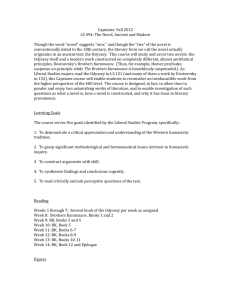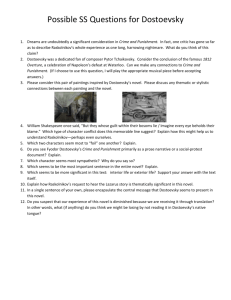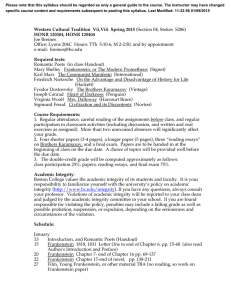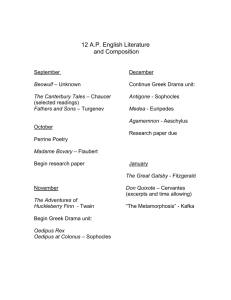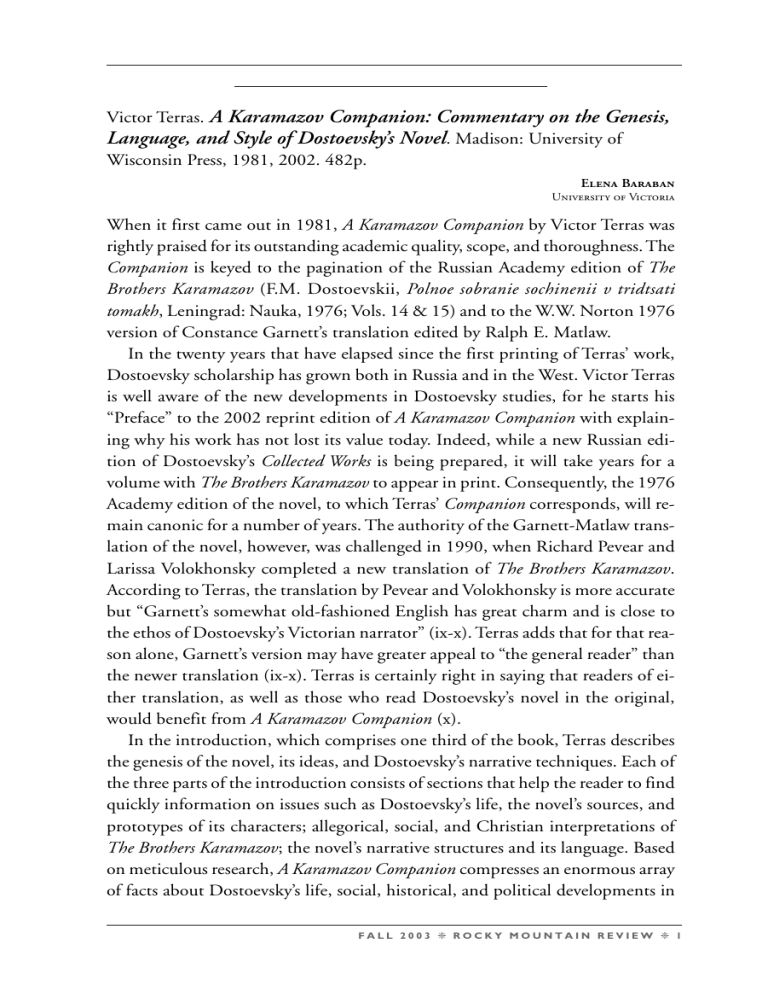
Victor Terras. A Karamazov Companion: Commentary on the Genesis, Language, and Style of Dostoevsky’s Novel. Madison: University of Wisconsin Press, 1981, 2002. 482p. Elena Baraban University of Victoria When it first came out in 1981, A Karamazov Companion by Victor Terras was rightly praised for its outstanding academic quality, scope, and thoroughness. The Companion is keyed to the pagination of the Russian Academy edition of The Brothers Karamazov (F.M. Dostoevskii, Polnoe sobranie sochinenii v tridtsati tomakh, Leningrad: Nauka, 1976; Vols. 14 & 15) and to the W.W. Norton 1976 version of Constance Garnett’s translation edited by Ralph E. Matlaw. In the twenty years that have elapsed since the first printing of Terras’ work, Dostoevsky scholarship has grown both in Russia and in the West. Victor Terras is well aware of the new developments in Dostoevsky studies, for he starts his “Preface” to the 2002 reprint edition of A Karamazov Companion with explaining why his work has not lost its value today. Indeed, while a new Russian edition of Dostoevsky’s Collected Works is being prepared, it will take years for a volume with The Brothers Karamazov to appear in print. Consequently, the 1976 Academy edition of the novel, to which Terras’ Companion corresponds, will remain canonic for a number of years. The authority of the Garnett-Matlaw translation of the novel, however, was challenged in 1990, when Richard Pevear and Larissa Volokhonsky completed a new translation of The Brothers Karamazov. According to Terras, the translation by Pevear and Volokhonsky is more accurate but “Garnett’s somewhat old-fashioned English has great charm and is close to the ethos of Dostoevsky’s Victorian narrator” (ix-x). Terras adds that for that reason alone, Garnett’s version may have greater appeal to “the general reader” than the newer translation (ix-x). Terras is certainly right in saying that readers of either translation, as well as those who read Dostoevsky’s novel in the original, would benefit from A Karamazov Companion (x). In the introduction, which comprises one third of the book, Terras describes the genesis of the novel, its ideas, and Dostoevsky’s narrative techniques. Each of the three parts of the introduction consists of sections that help the reader to find quickly information on issues such as Dostoevsky’s life, the novel’s sources, and prototypes of its characters; allegorical, social, and Christian interpretations of The Brothers Karamazov; the novel’s narrative structures and its language. Based on meticulous research, A Karamazov Companion compresses an enormous array of facts about Dostoevsky’s life, social, historical, and political developments in FALL 2003 ❈ ROCKY MOUNTAIN REVIEW ❈ 1 Russia, religious and philosophic thought. In addition, Terras presents the gist of the main critical discussions of the novel’s themes, ideas, characters, and language. Diverse interpretations of The Brothers Karamazov reflect the novel’s complexity, its significance for the discussion of the Orthodox Church’s position in Russian society, the moral effects of nihilism, the Slavophile versus Westernizers debate, and many other issues. Rather than providing ready-made conclusions about the meaning of The Brothers Karamazov, Terras’ book illuminates intricacies and contradictions in Dostoevsky’s last novel and helps the reader appreciate Dostoevsky’s art more fully. In the commentary, organized according to the twelve books and the epilogue of the novel, Terras authoritatively explains Dostoevsky’s use of literary and biblical quotations and allusions, irony, puns, symbols, imagery, leitmotifs, and other stylistic devices. He clarifies and explicates the meanings of passages that are difficult to interpret or those whose meaning is lost in the translation. In writing his commentary, Terras relied, among other things, on the detailed Russian commentary to the novel (Vol. 15 of the Academy edition). Thanks to Terras, the wealth of the Russian commentary has become available to English readers of The Brothers Karamazov. Taking into consideration the fact that many readers of the Companion may not be familiar with Dostoevsky studies, it would have been useful to include in the reprint edition an additional bibliography listing major works on The Brothers Karamazov that have come out in the last two decades. For example, new studies of Dostoevsky include such works as Reading Dostoevsky (1998) by Terras himself, The Brothers Karamazov: Worlds of the Novel (1992) by Robin Feuer Miller, and a remarkable multi-volume biography of Dostoevsky by Joseph Frank completed in 2002. Nevertheless, one only has to remind oneself that in preparing A Karamazov Companion, Terras examined Dostoevsky scholarship that had amassed over almost a century since the 1880 publication of The Brothers Karamazov. Exceptionally informative and written in a lucid manner, Terras’ book remains an excellent introduction to The Brothers Karamazov. The general public, students, scholars, and teachers will find A Karamazov Companion extremely useful. ❈ 2 ❈ R O C K Y M O U N TA I N R E V I E W ❈ F A L L 2 0 0 3
